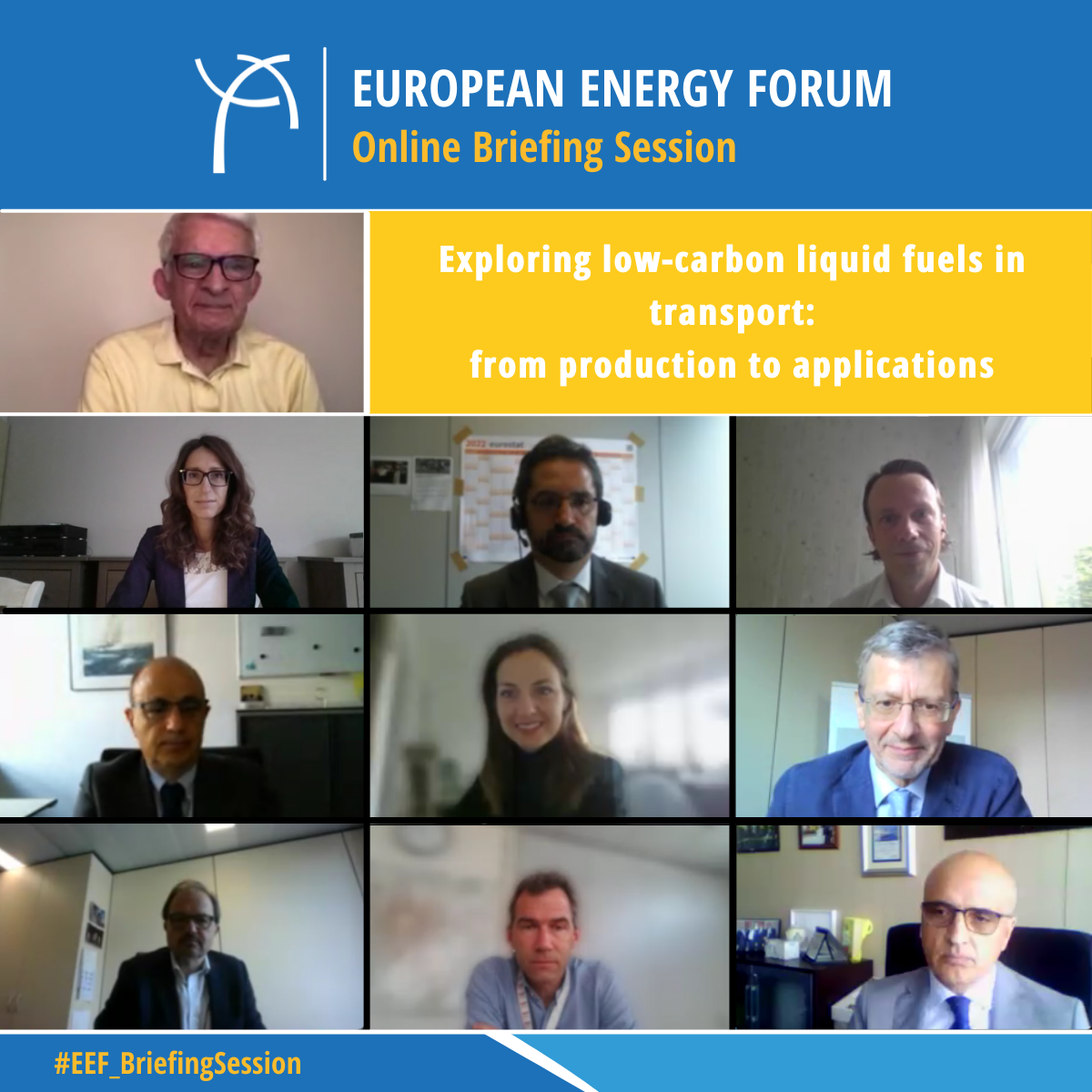Exploring low-carbon liquid fuels in transport: from production to applications
Chair:
MEP Jerzy Buzek (EPP, Poland), President of the EEF
Speakers:
Alessandro Bartelloni, Director, FuelsEurope
Alain Mathuren, Communication Director, FuelsEurope and Concawe
Emanuela Sardellitti, Advocacy Executive, FuelsEurope
Michele Viglianisi, Circular Economy & Green Refineries Director, Eni Spa
Massimo Gai, EU Renewable Energy Strategy Implementation Manager, ExxonMobil
Michiel van Raebroeckx, General Manager Grandpuits Platform, TotalEnergies
Teemu Sarjovaara, Head of R&D, Products and applications, Neste
Dario Dubolino, Policy Officer, Sustainable and Intelligent Transport Unit, DG MOVE, European Commission
Moderator:
Pascale Verheust, Director General of the EEF
EEF President MEP Jerzy Buzek chaired the online educative briefing on low-carbon liquid fuels (LCLFs)
As it’s typically the case for EEF briefings, explanations started from the very basics of things. Alessandro Bartelloni, Director of FuelsEurope, offered clarifications on some key terms: low-carbon liquid fuels, zero-carbon liquid fuels, and drop-in fuels. He explained the same fuel can be defined either as low- or zero-carbon based on the approach adopted – a tailpipe or a well-to-wheel approach -, and that the main advantage of drop-in fuels is the possibility of using them with current infrastructure, without any modification needed. LCLFs can be produced from a variety of feedstock and with different technologies, based on which they are categorised either as biofuels or synthetic fuels.
Once the terminology clarified and the production technologies presented, he passed the floor on to his colleague Alain Mathuren, Communication Director at FuelsEurope, who showcased LCLFs environmental performance by using the Life Cycle Assessment (LCA) CO2 comparator. The comparison between battery electric vehicles, hybrid vehicles and plug-in hybrid vehicles showed the different technologies will be able to deliver almost the same level of emission reduction once hybrid vehicles will run on 100% renewable fuels. LCLFs could thus make clean transport affordable to all. This is key, especially considering that today, battery electric vehicles are only affordable for a small part of EU population and – in most cases – provided dedicated support measures are in place, as a study that was presented us by Emanuella Sardellitti, Advocacy Executive at FuelsEurope, has found.
After this overview on LCLFs, time came to focus on the state-of-play of LCLFs development in the EU.
That was possible thanks to Michele Viglianisi – Head of biorefining and supply at Eni, Massimo Gai – EU Renewable Energy Strategy Implementation Manager of ExxonMobil, Michiel Van Raebroeckx – General Manager Grandpuits Platform at TotalEnergies, and Teemu Sarjovaara – Head of R&D at Neste, who in turn presented the main projects their respective companies are working on.
Their presentations covered LCLFs being developed for all transport modes – from road transport to aviation and maritime – and both inside and outside the EU. They told us how their companies have been transforming their traditional refineries into biorefineries dedicated to biofuels production.
They presented the eco-fining process, the gasification and Fischer-Tropsch process, and the HEFA (hydro-processed esters and fatty acids) technology. It was explained that among the 7 technology pathways approved for sustainable aviation fuels production, the HEFA it is the only commercially available today at industrial scale.
The speakers agreed that the potential for renewable fuels scalability is significant, especially since most technologies are flexible and can be operated with a large set of feedstocks. As the sustainable fuels quantity required to decarbonise the transport sector is significant, a wide portfolio of different feedstocks is indeed crucial. Yet the development of LCLFs technologies requires time: for LCLFs to be market-ready and available at scale in 2050, investments must be made today. A stable and clear regulatory framework to drive them is thus key.
The interventions from the energy industry were complemented by one from Dario Dubolino, policy officer at the Sustainable and Intelligent Transport unit of DG MOVE, European Commission. He first clarified EU legislation differentiates between renewable fuels for transport – biofuels, biogas and RNFBOs – and low-carbon fuels – low-carbon hydrogen, synthetic gaseous and liquid fuels produced from low-carbon hydrogen. The EC has been promoting these fuels through several initiatives and Mr. Dubolino focused on those DG MOVE is directly responsible for: the ReFuelEU Aviation, the FuelEU Maritime and the Renewable and Low-carbon Fuels Alliance. While the first two aim to set targets and put enforcement measures in place, the Low-carbon Fuels Alliance brings together several stakeholders to identify best practices and strengthen weaknesses, with the aim of helping boost the development, availability and affordability of renewable and low-carbon fuels in aviation and maritime transport. Alongside this, the EC has put in place several other initiatives, which according to Mr. Dubolino shows the complexity and variety of the solutions available.



